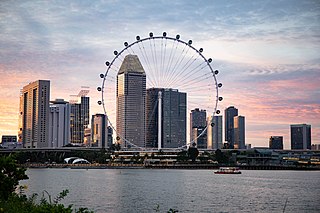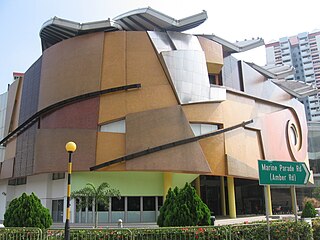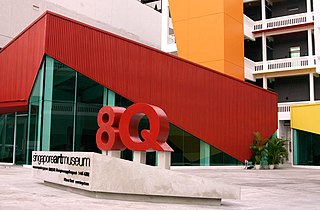
60 Waterloo Street is a historic bungalow on Waterloo Street in downtown Singapore. A second four-storey building was constructed behind the bungalow when the Dance Ensemble Singapore moved into the bungalow in 1995.

60 Waterloo Street is a historic bungalow on Waterloo Street in downtown Singapore. A second four-storey building was constructed behind the bungalow when the Dance Ensemble Singapore moved into the bungalow in 1995.
The two-storey building is symmetrical and features high ceilings, tall windows and a red pitched tile roof, and it is surrounded by a garden compound with a wrought iron gate. [1] Arched doorways can be found on the ground floor while the French windows on the upper floor are covered with timbre louvred shutters. [2]
The home served as the residence of A. S. Desker, a prominent member of the Eurasian community of Singapore, and his wife, Mary Caroline Elisabeth. In 1919, the company owned by prominent businessman Tan Kah Kee listed the building for rent. In 1923, the Massage Hall, which was owned by a Mrs Haru and a Miss Hana and was previously on Bencoolen Street, moved into the building. The business continued to operate until September 1941. [1]
After World War II, the building was purchased by the Jewish Welfare Board, after which it was converted into the old folks' home. [3] The Urban Redevelopment Authority took over ownership of the vacant building in 1983. In 1986, three businessmen rented the building from the authority and converted it into the Waterloo Food Paradise, an eating house 8 hawker stalls. [4] The Tai Chuan Eating House occupied the building around 1990. [2]
From 1995 to 1996, the building underwent a $1.28 million renovation and restoration under the National Arts Council Arts Housing Scheme, after which theatre organisation Dance Ensemble Singapore moved into the bungalow, which then included five dance studios. It was officially reopened by Loh Meng See, then a Member of Parliament representing the Kampong Glam Group Representation Constituency, on 25 May 1996. [5] A four-storey annex building, featuring eight dance studios, a music room, a conference room, two instructors' rooms and a costume room, was constructed behind the bungalow. [1]
The building is one of several on Waterloo Street to have been renovated under the scheme, along with the Stamford Arts Centre, 42 Waterloo Street, the Singapore Calligraphy Centre, which houses the Chinese Calligraphy Society of Singapore, and 54-58 Waterloo Street, which currently houses The Theatre Practice. [6]

A bungalow is a small house or cottage that is single-story, and may be surrounded by wide verandas.

The Arts House is a multi-disciplinary arts venue in Singapore. The venue plays host to art exhibitions and concerts. Built in 1827, the Old Parliament House is the oldest government building and perhaps the oldest surviving building in Singapore. The building was home to the Parliament of Singapore from 1965 to 1999, when it moved to an adjacent new building.

Nanyang Academy of Fine Arts is a publicly-funded post-secondary arts institution in Singapore, and a constituent college of the University of the Arts Singapore (UAS) from 2024.

This article shows the notable future developments in Singapore. Most of them are currently under construction with most to be completed within the next five years.

One-north is a subzone of Queenstown, Singapore, first developed by JTC Corporation as the country's research and development and high technology cluster. It was first conceptualised in 1991 as part of the National Technology Plan and officially launched on 4 December 2001 by then Deputy Prime Minister Tony Tan Keng Yam.

Kwan Im Thong Hood Cho Temple is a traditional Chinese temple situated at 178 Waterloo Street in Singapore. The temple is of significance to the Buddhist community among Chinese Singaporeans, and is believed to bring worshippers good luck after praying to the Kuan Yin or Avalokiteśvara, the Goddess of Mercy. The temple is also involved in charity work, contributing to several health and educational organisations.

Sungei Road is a road in Singapore situated between Serangoon Road and Jalan Besar and runs along the Rochor Canal. The area around Sungei Road formerly housed affluent Europeans and Asians, and many ornately designed buildings were built there. Since the 1930s, the road has been synonymous with Sungei Road laksa and the Thieves' Market, the largest and oldest flea market in Singapore, where locals can shop for old bric-a-brac or second-hand goods. The market was permanently closed on 10 July 2017 for "future residential development use".

Tan Teck Guan Building is a historic building on College Road, within the compound of Singapore General Hospital in Bukit Merah, Singapore. The building currently houses offices of the Ministry of Health.

Marine Parade Community Building was a community centre located at 278 Marine Parade Road, Singapore. Opened on 6 March 2000, it houses the formerly separate Marine Parade Community Centre and Marine Parade Public Library, as well as a performing arts group, The Necessary Stage. Designed by William Lim Associates, one of the distinguishing features of the postmodern building is the mural cladding called the "Texturefulness of Life", the largest piece of installation art in Singapore. It was demolished in 2022 and is being rebuilt.

SAM at 8Q is the annexe of Singapore Art Museum - Singapore's contemporary art museum. Located at the heart of the city, it derives its name from the museum's location at No. 8 Queen Street near Bras Basah Road. SAM at 8Q is also approximately 88 steps away from Singapore Art Museum.
The Former Command House is a historic building, located at Kheam Hock Road in Singapore. It was the residence of the General Officer Commanding (GOC) of Malaya during British colonial period.
Selegie House is a public housing complex which includes blocks 8-10 along Selegie Road in Singapore.

Singapore Calligraphy Centre, also known as 48 Waterloo Street, is a bungalow on Waterloo Street in downtown Singapore which currently houses the Chinese Calligraphy Society Of Singapore.

54-58 Waterloo Street is a row of three consecutive and adjoining terrace houses on Waterloo Street in downtown Singapore, which currently houses The Theatre Practice.

42 Waterloo Street is a historic bungalow on Waterloo Street in downtown Singapore, which currently houses Centre 42.
Singapore Council of Women's Organisations Centre, also known as 96 Waterloo Street, is a historic bungalow on Waterloo Street in downtown Singapore. It currently houses the Singapore Council of Women's Organisations.

Stamford Arts Centre is an arts centre on Waterloo Street in downtown Singapore. The building previously served as the Japanese National School, the former premises of the Gan Eng Seng School, the Stamford Girls' School and the Stamford Primary School.
124 and 126/126A St. Patrick's Road are two bungalows on Saint Patrick's Road in the Frankel subzone of Bedok, Singapore. The two bungalows were integrated into a condominium complex in 2006.

Bras Basah Complex is a mixed-use building on Bain Street in Bras Basah, Singapore that houses both residential and commercial units. From the 1980s to the early 2000s, it was known for its numerous bookstores. It was also a popular venue amongst xinyao singers in the 1980s.
Boulevard Hotel was a hotel on Orchard Boulevard in the Orchard Planning Area in Singapore. Opened on Cuscaden Road in 1968 as the Cuscaden House Hotel, it closed down in 1974 before being acquired by Hotel Malaysia Limited, who reopened it as the Hotel Malaysia in 1976. In 1983, the hotel received an extension, after which its main entrance was shifted to Orchard Boulevard. It was also renamed the Boulevard Hotel. The hotel closed down in 2000 before being demolished to make way for a condominium complex.